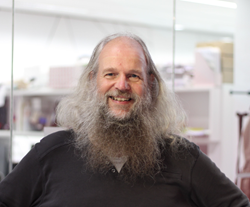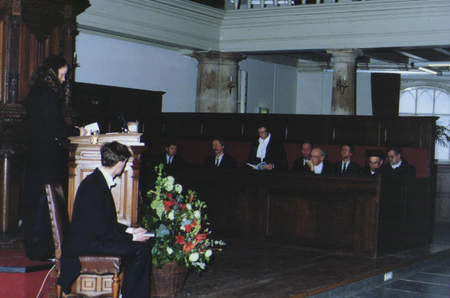Interview with Marcel van Herk,
recipient of the Emmanuel van der Schueren Award at ESTRO 2024
|

|
Marcel van Herk
University of Manchester
United Kingdom
|
The Emmanuel van der Schueren Award is given in honour of the founding father of ESTRO and in recognition of excellent scientific work, enormous contributions within ESTRO to the field of education and the promotion of radiation oncology as a discipline.
The recipient of this award will deliver a lecture at the ESTRO annual congress.
Congratulations on being honoured with the Emmanuel van der Schueren Award! Can you share your initial thoughts and feelings upon learning about this prestigious recognition of your scientific work and contributions to radiation oncology education within ESTRO?
I am very happy to receive this award and it has given me a warm feeling to be recognised by my peers. I moved to become chair in radiotherapy physics in Manchester nine years ago, and I feel that this award not only recognises me personally but also highlights the fantastic contributions of both my new and my former groups. Although I have done a lot of teaching throughout my career (for 25 years now), I feel it is only a small part of my work, albeit a part that has reached many thousands of students, and I still find a lot of enjoyment in it. For ESTRO I started teaching in the target volume delineation (TVD) course, then in the image-guided radiotherapy course, and relatively recently I joined the advanced treatment planning course.
The award is named after the founding father of ESTRO, Emmanuel van der Schueren. How has his legacy influenced your career in radiation oncology and your contributions to the field?
I have known Manu van der Schueren personally, having collaborated on an EU project that introduced a then newly developed electronic portal imaging device for clinical use. A fun fact about us is that we loaded three portal imaging devices in the trunk of a car and drove together to Leuven to drop one off there, dropped another off in Dijon and ended our journey in Florence, where we dropped off the final device. Manu was also an examiner at my spoken defence exam (viva) for my PhD, which is a very festive but formal affair in The Netherlands. He and my former chief Harry Bartelink founded ESTRO. I think that as radiotherapy researchers, we all have to be forever thankful that we have such a great platform through which to share and celebrate our work.

"Manu was also an examiner at my spoken defence exam (viva) for my PhD":
Marcel (left) and Emmanuel van der Schueren (far left in the jury) .
You are recognised for excellent scientific work and a substantial contribution to education within ESTRO. Could you highlight some of the key projects or initiatives you have been involved in that have led to this acknowledgment?
My first job was to develop and introduce portal imaging, hardware, software and protocols. I feel that this work was instrumental in making staff in the field aware of uncertainties, such as organ motion and delineation uncertainties. A logical follow-up was to quantify these uncertainties, starting with set-up errors but later including those mentioned.
In the meantime, I worked on automatic image registration. I may be most well-known for the margin recipe, which was very much a group effort and is still the backbone necessary to understand the impact of uncertainties on radiotherapy delivery. In about 2000, we got involved with Elekta through our friends in William Beaumont University Hospital in Detroit, and as a result the Netherlands Cancer Institute (NKI) was one of the centres that obtained a prototype of the XVI cone-beam computed tomography-guided treatment machine. Integrating our existing methods and knowledge, we created the software package. This was the first for internal use. Later it was licensed to Elekta and has since been used for millions of patients. This software is still in use almost 20 years after its creation.
Currently, I focus more on the next weakest link in the radiotherapy chain: the lack of knowledge about the biological effects of radiotherapy. At this annual ESTRO, I will present a profferred talk on a causal inference method that can be used to estimate dose-effect relationships and which is insensitive to confounding variables.
As part of the award tradition, you will be delivering a lecture at the ESTRO congress. Can you provide a glimpse into the topics or insights you plan to share during your lecture, and what messages you hope to convey to your colleagues in the field?
The main focus of my award presentation is that the development of new technology should go hand-in-hand with education. I will show examples of situations in which technology has failed due to a lack of education, and conversely, those in which technology has succeeded because there were ample educational activities. Education is essential to ensure that new technologies are introduced and used effectively and safely!
Looking back at your journey within ESTRO, how do you perceive the evolution of radiation oncology education, and what do you envision for its future?
I have always been an advocate of hands-on teaching. I and my colleagues at NKI introduced online contouring in 2004 to the ESTRO TVD course. Apart from that, I have taught many hands-on workshops. One example was a workshop about image registration and, of course, advanced treatment planning.
Operating the software yourself enables you to understand the materials and ideas so much better than you can by just listening to a lecture. Even when a hands-on approach is not possible, I always like to demonstrate essential ideas by showing clinical software or software that has been developed especially for teaching, such as a simulator that shows the effect of geometrical uncertainties on the target dose.
The Emmanuel van der Schueren Award recognises not only scientific excellence but also significant contributions within ESTRO. How has your involvement in ESTRO shaped your professional development and influenced your perspective on the broader field of radiation oncology?
My involvement with ESTRO is mostly from the teaching side. However, at the meetings, I love to start the party and I feel ESTRO parties have definitely been shaped in some ways by me. Professionally, I am currently involved in the ESTRO working group on clinical target volume definition. This topic fits very well with my long-standing interest in margins and uncertainties, and with my current work to develop methods to increase knowledge by learning from all patients treated in the past.
Given the dynamic advancements in technology and treatment modalities, how do you see the role of education in ensuring that professionals stay abreast of the latest developments in radiation oncology?
It is essential. There are many pitfalls with new and existing equipment and methods, and these must be brought over to young and old.
Can you share a memorable moment or accomplishment in your career that you believe has had a lasting impact on the field, contributing to your receipt of the Emmanuel van der Schueren Award?
Seeing, for the first time, images from a system that you developed on a slide that is not from somebody you know – that has happened to me twice; once for the Varian PortalVision electronic portal imaging device, in about 1992, and once for XVI in 2005. A very warm feeling.
Finally, what advice would you offer to young professionals aspiring to make meaningful contributions to radiation oncology and to follow in the footsteps of esteemed figures like Emmanuel van der Schueren?
Do what you enjoy and try to bring your special knowledge from outside the field of radiotherapy, into your role. By combining knowledge from many disciplines, we can further the field. Who better to bring those skills than somebody who enjoys a field so much that they have it as a hobby? I brought in electronics and computers; others can bring in statistics, mathematics, psychology, philosophy or whatever rocks their boat.